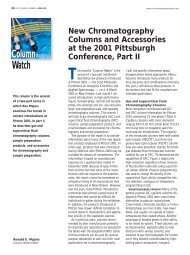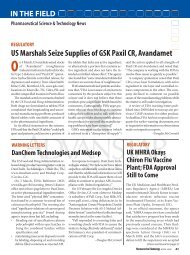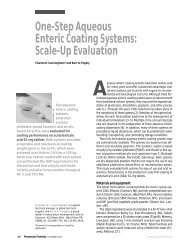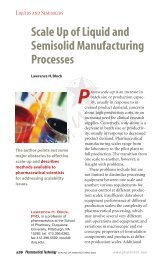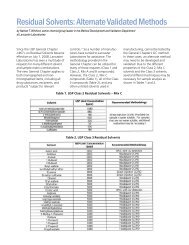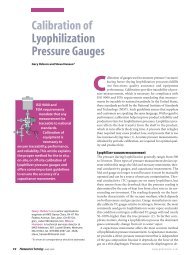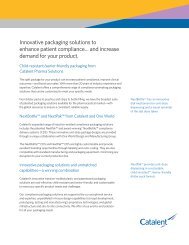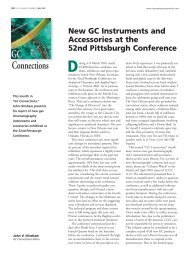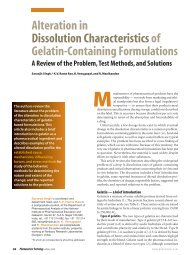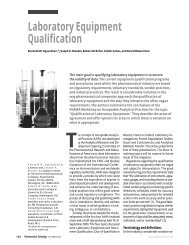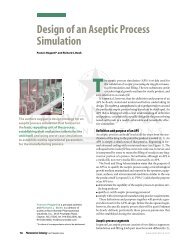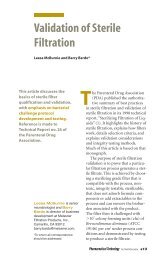360 Feedback - Pharmaceutical Technology
360 Feedback - Pharmaceutical Technology
360 Feedback - Pharmaceutical Technology
You also want an ePaper? Increase the reach of your titles
YUMPU automatically turns print PDFs into web optimized ePapers that Google loves.
Contract Services<br />
Relationship Management<br />
<strong>360</strong> <strong>Feedback</strong> —<br />
Improving the Selection<br />
Process All the Way Around<br />
Jim Miller<br />
Sponsors can use <strong>360</strong> feedback to rate<br />
a contract research organization (CRO)’s<br />
performance or to evaluate employees.<br />
In either instance, it can lead to a better<br />
partnership and relationship.<br />
THIS MONTH:<br />
122 Relationship Management:<br />
<strong>360</strong> <strong>Feedback</strong> —<br />
Improving the Selection<br />
Process All the Way Around<br />
128 Outsourcing Outlook<br />
132 Entering into an<br />
Alliance with Big Pharma<br />
Anton Gueth<br />
MASTER SERIES<br />
Jim Miller is president of<br />
PharmSource Information<br />
Services, Inc. and publisher of<br />
Bio/<strong>Pharmaceutical</strong> Outsourcing<br />
Report, tel. 703.914.1203,<br />
info@pharmsource.com,<br />
www.pharmsource.com.<br />
<strong>Pharmaceutical</strong> companies typically<br />
evaluate both current and potential<br />
CRO partners using a linear<br />
process. The feedback flows only<br />
one way — from sponsor to vendor —<br />
and may be restricted to people in management<br />
positions.<br />
Traditionally, <strong>360</strong> feedback is used in<br />
corporations to give individuals feedback<br />
about their performance. Input is provided<br />
from a range of colleagues who interact<br />
regularly with the person being evaluated,<br />
including supervisors, coworkers, and<br />
subordinates who are representative of the<br />
stakeholders in the person’s performance.<br />
Howard Williams, executive consultant<br />
with Personnel Decisions International<br />
(Boston, MA) says the <strong>360</strong> approach has<br />
two major advantages: first, the subject<br />
receives a more extensive evaluation than<br />
typically is given in a linear supervisor–<br />
subordinate assessment; and second, because<br />
multiple observers are used, the information<br />
is more likely to be accurate<br />
than the information gathered during traditional<br />
evaluation processes.<br />
Williams makes the case for using <strong>360</strong><br />
feedback both for choosing new CROs and<br />
rating existing ones. “<strong>360</strong> feedback can<br />
lead to a better partnership and a better<br />
relationship,” claims Williams.<br />
Core criteria<br />
Sponsors can effectively use <strong>360</strong> feedback<br />
to rate a CRO’s performance, says<br />
Williams. Ideally, this process would be<br />
linked to the selection process for evaluating<br />
potential outsourcing partners.<br />
The evaluation process should be linked<br />
to the core criteria that are required for a<br />
vendor to successfully execute a project.<br />
Sponsors should list the essential tangible<br />
and intangible characteristics that the<br />
project requires for successful execution<br />
by the CRO. Leadership skills, technical<br />
knowledge, plant capacity, turnaround<br />
time, and financial outlay are examples of<br />
areas in which core criteria should be examined,<br />
notes Williams.“Basically, you’re<br />
asking, ‘What do we want in a partner?’”<br />
he says. The criteria also should reflect a<br />
company’s long-term values and what it<br />
expects from its outsourcing partners. To<br />
establish the criteria, it may be necessary<br />
to form an internal focus group that identifies<br />
the key needs and values it expects a<br />
vendor to match.<br />
Once the core criteria are in place, the<br />
122 <strong>Pharmaceutical</strong> <strong>Technology</strong> OCTOBER 2001 www.pharmtech.com
Contract Services<br />
company can link them to the <strong>360</strong> feedback<br />
process. At this stage, a sponsor team<br />
is selected to evaluate the CRO in each area<br />
of the core criteria model. The evaluators<br />
should come from various departments —<br />
research and development, marketing,<br />
manufacturing, etc. — and should range<br />
from executives to project managers to line<br />
workers.<br />
“Anyone with a stake in the project’s<br />
success should be involved,” says Williams.<br />
He suggests choosing people diagonally<br />
— in other words, avoid putting people<br />
on the team who directly report to each<br />
other. “If we can get stakeholders at different<br />
levels, we get a better mix than if we<br />
do it horizontally.” The mix is important<br />
because each department and level brings<br />
a different perspective to the evaluation<br />
process.<br />
“You may even go outside the organization<br />
in some cases,” he suggests. This may<br />
include getting feedback from the CRO’s<br />
existing clients or from consultants who<br />
regularly help sponsors manage studies.<br />
No matter who is doing the evaluating,<br />
Williams prefers to restrict the size<br />
of the team. “We like to use between<br />
four and six observers,” he<br />
says. Less than four, and feedback<br />
isn’t accurate; but once the team<br />
gets into double digits, the feedback<br />
tends to be redundant.<br />
The team members rate the<br />
vendor on the basis of the established<br />
core criteria. Once the feedback<br />
has been compiled, it can be<br />
analyzed in various ways depending<br />
on the sponsor’s needs, says<br />
Williams. When used for vendor<br />
selection, the feedback can identify<br />
the vendor that most closely<br />
matches the required core criteria.<br />
Project<br />
director<br />
Analytical<br />
chemist<br />
CRO<br />
Quality<br />
assurance<br />
Sourcing<br />
specialist<br />
Process<br />
chemist<br />
Figure 1: Evaluating a CRO with <strong>360</strong> feedback.<br />
Planning for development<br />
Whether <strong>360</strong> feedback is used to choose<br />
a vendor or to evaluate an employee, it’s<br />
essential to follow through with a development<br />
plan. “Otherwise, what’s the<br />
point?” asks Williams.<br />
For a CRO, the initial <strong>360</strong> process<br />
serves as a baseline. Although it may indicate<br />
that the CRO has the necessary capabilities<br />
and qualities to carry out the<br />
project, the preselection <strong>360</strong> feedback<br />
evaluation will identify areas that the CRO<br />
should work on — and that the sponsor<br />
should monitor — during implementation.<br />
Once the project is completed, a postproject<br />
evaluation can establish what<br />
worked, what didn’t, and what should be<br />
improved.<br />
Circle/eINFO 82<br />
124 <strong>Pharmaceutical</strong> <strong>Technology</strong> OCTOBER 2001 www.pharmtech.com
Contract Services<br />
The <strong>360</strong> feedback process<br />
can take time, but most clients<br />
agree that the investment is<br />
worth it.<br />
But a postproject evaluation<br />
also should be a<br />
two-way process.“Yes, it’s<br />
a form of benchmarking<br />
— how the CRO stacks<br />
up, and what it can do<br />
better,”Williams says.“But<br />
to build a better partnership,<br />
feedback has to come<br />
from the CRO as well.”<br />
Ideally, another <strong>360</strong> feedback session<br />
should be scheduled about a year after the<br />
original baseline evaluation. This one<br />
should be conducted using evaluators from<br />
both sides, and both the CRO and the<br />
pharmaceutical company should be reviewed.<br />
After the data have been collected,<br />
the two parties should meet.<br />
“You want both sides to sit down in the<br />
same room and talk,” says Williams. The<br />
session should end with a three-column<br />
list — what works, what doesn’t, and what<br />
is a priority for improvement. The group<br />
should formulate an action plan outlining<br />
what steps will be taken, and by<br />
whom, to bring about the required change.<br />
Typically, such a session would be driven<br />
by the sponsor, notes Williams, but he argues<br />
that there should be a joint chairperson<br />
at that point.“If you can get to this<br />
stage, it’s a great way to see where the companies<br />
stand,” he says.<br />
Unfortunately, many companies who<br />
start the <strong>360</strong> feedback process aren’t willing<br />
to put the required resources behind<br />
it. An internal champion is essential, notes<br />
Williams. Without a high-level person to<br />
make things happen, it’s likely the process<br />
will stall before it reaches the feedback<br />
session.<br />
Seeing improvements can take time. But<br />
Williams, who has used the process at<br />
companies ranging from new dot-coms<br />
to global financial institutions, argues that<br />
most clients find the investment worth it.<br />
“If a company can connect its recruiting,<br />
selection, and development processes<br />
to <strong>360</strong> feedback when selecting their staff,<br />
they’ll see major changes in productivity.<br />
When used to select vendors, they’ll see<br />
improvements in cost reductions, timelines,<br />
and quality,” he says. PT<br />
For more information, please contact<br />
Howard Williams, executive consultant at<br />
Personnel Decisions International, Boston,<br />
MA, tel. 617.587.4805, howard.williams@<br />
personneldecisions.com.<br />
Circle/eINFO 84<br />
126 <strong>Pharmaceutical</strong> <strong>Technology</strong> OCTOBER 2001 www.pharmtech.com



